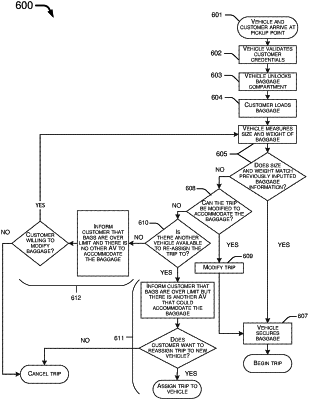| CPC G06Q 50/30 (2013.01) [G06F 16/24 (2019.01); G06V 20/56 (2022.01)] | 11 Claims |

|
1. A method, comprising:
generating at least one of an image of a baggage and a three-dimensional (3D) scan of the baggage, wherein the image is generated by a camera and the 3D scan is generated by a 3D scanner;
receiving, by a first processor from a second processor, a transportation request, wherein the first processor is included within a network of distributed processors each disposed in a respective vehicle of a fleet of vehicles comprising a plurality of vehicles and communicatively coupled to the second processor, wherein the transportation request comprises itinerary data and baggage data relevant to transporting a baggage, a passenger, or both, from a pickup location to a destination, wherein the itinerary data comprises information relevant to the pickup location and information relevant to the destination, wherein the baggage data comprises information relevant to a size of the baggage and information relevant to a weight of the baggage, wherein the information relevant to the size of the baggage comprises a measured dimension of the baggage and at least one of the image of the baggage generated by the camera and the 3D scan of the baggage generated by the 3D scanner, and wherein the information relevant to the weight of the baggage comprises a measured weight of the baggage or an estimated weight of the baggage;
accessing, by the first processor, a database storing capacity data of the fleet of vehicles, wherein the database comprises a distributed database comprising a network of memory elements each disposed in the respective vehicle of the fleet of vehicles, wherein the capacity data records, for each vehicle of the fleet of vehicles, a loading situation of one or more baggage compartments of the respective vehicle, each of the one or more baggage compartments respectively having a size capacity and a weight capacity, wherein the loading situation comprises a baggage space of the one or more baggage compartments of the respective vehicle, the baggage space being at least one of virtually divisible or combinable by a virtual adjustment and physically divisible by use of one or more physical dividers such that the baggage space is divisible or combinable into the one or more baggage compartments of the respective vehicle, and wherein the respective vehicle is capable of updating the capacity data of the respective vehicle in a real-time manner;
selecting, by the first processor, a vehicle of the fleet of vehicles based on the transportation request and the capacity data, wherein the capacity data comprises a positive size tolerance, a negative size tolerance, a positive weight tolerance, and a negative weight tolerance; and
performing, by the vehicle, a transportation service that fulfills the transportation request, wherein performing the transportation service that fulfills the transportation request comprises:
unlocking a baggage compartment based on:
determining, by the vehicle, an estimated size of the baggage based on the image of the baggage or the three-dimensional (3D) scan of the baggage;
obtaining the measured weight of the baggage by a weight scale on the vehicle;
verifying that the estimated size is within the positive size tolerance and the negative size tolerance from the size of the baggage indicated by the baggage data; and
verifying that the measured weight is within the positive weight tolerance and the negative weight tolerance from the weight of the baggage indicated by the baggage data;
securing, by the vehicle, the baggage, the passenger, or both, to the vehicle at the pickup location;
transporting, by the vehicle, the baggage, the passenger, or both, from the pickup location to the destination; and
releasing, by the vehicle, the baggage, the passenger, or both, from the vehicle at the destination.
|